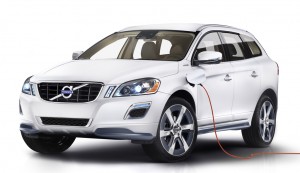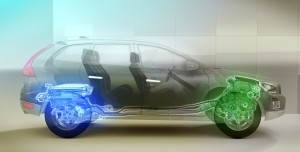Volvo showed off a unique hybrid system that it says will use the car’s kinetic energy to provide excellent fuel economy while still producing the performance luxury buyers have grown accustomed to.
Volvo President and CEO Stefan Jacoby said the XC60 Plug-in Hybrid Concept it showed Monday at the Detroit Auto Show is first vehicle to combine an all-electric range of about 35 miles, true luxury car performance capability, all in spacious crossover.
“The technology in the XC60 Plug-in Hybrid Concept is as ingenious as it is unique,” Jacoby said. “You can make really green progress on the road without compromising on any of the luxury car’s renowned properties.”
The powertrain features a new 2.0-liter turbocharged four-cylinder engine producing 280 horsepower with an eight-speed automatic transmission and an integrated starter/generator generating 45 horsepower, driving the front wheels. The second part of the system uses a 70-horsepower electric motor putting power to the rear wheels.
The system has three driving modes: Pure (all electric), Hybrid and Power. In Pure mode, Volvo said the system is capable of returning 105 mpg equivalent. The driver chooses the mode via buttons on the center console. The company said the combined fuel economy is about 50 mpg, yet the small crossover is still capable of accelerating to 60 in 5.8 seconds in Power mode, which uses the gasoline engine and the two electric motors to produce about 350 combined horsepower.
At the heart of the hybrid system is Flywheel KERS, which stands for Kinetic Energy Recovery System.

Volvo put its plug-in hybrid powertrain into its familiar XC60 crossover, but the automaker has not yet decided which production vehicle would be the first to get the system.
The flywheel drive system is fitted to the car’s rear axle, while the engine powers the front wheels. When the brakes are applied, the resulting braking energy causes the flywheel to spin at up to 60,000 revolutions a minute. Once the car starts moving again, the flywheel’s rotation is transferred to the rear wheels via a specially designed transmission unit, providing up to 80 additional horsepower. With this arrangement, the total power of the engine and KERS is applied to all four wheels, Volvo said.
Volvo plans to be one of the first automakers in the world to begin testing a flywheel energy storage system in public roads by next fall.
The engine is part of new range powerplants called Volvo Environmental Architecture or VEA. Volvo said it will primarily focus on four cylinder engines, but the system, based on a standard of 500 cc per combustion chamber, could also work for three-cylinder variants. The common architecture will reduce the number of unique parts by 60 percent, promote manufacturing efficiency, quality and efficiency of design projects.
“Both our new architecture and the new engine range will enable us to be on par or even beat our toughest competitors in crucial areas such as driving dynamics and fuel efficiency,” said Peter Mertens, Volvo’s senior vice president research and development.
While Volvo used the existing XC60 as the platform for the concept, it has not yet decided what vehicle it utilize the technology first.

